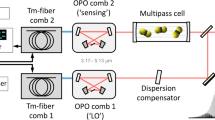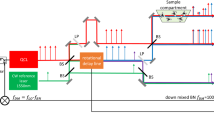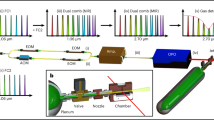Abstract
Molecular fingerprinting using absorption spectroscopy is a powerful analytical method, particularly in the infrared, the region of intense spectral signatures. Fourier transform spectroscopy—the widely used and essential tool for broadband spectroscopy—enables the recording of multi-octave-spanning spectra, exhibiting 100 MHz resolution with an accuracy of 1 × 10−9 and 1 × 10−2 in wavenumber and intensity determination, respectively. Typically, 1 × 106 independent spectral elements may be measured simultaneously within a few hours, with only average sensitivity. Here, we show that by using laser frequency combs as the light source of Fourier transform spectroscopy it is possible to record well-resolved broadband absorption and dispersion spectra in a single experiment, from the beating signatures of neighbouring comb lines in the interferogram. The sensitivity is thus expected to increase by several orders of magnitude. Experimental proof of principle is here carried out on the 1.5-µm overtone bands of acetylene, spanning 80 nm with a resolution of 1.5 GHz. Consequently, without any optical modification, the performance of Fourier spectrometers may be drastically boosted.
This is a preview of subscription content, access via your institution
Access options
Subscribe to this journal
Receive 12 print issues and online access
$209.00 per year
only $17.42 per issue
Buy this article
- Purchase on Springer Link
- Instant access to full article PDF
Prices may be subject to local taxes which are calculated during checkout




Similar content being viewed by others
References
Udem, T., Holzwarth, R. & Hänsch, T. W. Optical frequency metrology. Nature 416, 233–237 (2002).
Keilmann, F., Gohle, C. & Holzwarth, R. Time-domain mid-infrared frequency-comb spectrometer. Opt. Lett. 29, 1542–1544 (2004).
Schliesser, A., Brehm, M., Keilmann, F. and van der Weide, D. W. Frequency-comb infrared spectrometer for rapid, remote chemical sensing. Opt. Express 13, 9029–9038 (2005).
Coddington, I., Swann, W. C. & Newbury, N. R. Coherent multiheterodyne spectroscopy using stabilized optical frequency combs. Phys. Rev. Lett. 100, 013902 (2008).
Yasui, T., Saneyoshi, E. & Araki, T. Asynchronous optical sampling terahertz time-domain spectroscopy for ultrahigh spectral resolution and rapid data acquisition. Appl. Phys. Lett. 87, 061101 (2005).
Yasui, T., Kabetani, Y., Saneyoshi, E., Yokoyama, S. & Araki, T. Terahertz frequency comb by multifrequency-heterodyning photoconductive detection for high-accuracy, high-resolution terahertz spectroscopy. Appl. Phys. Lett. 88, 241104 (2006).
Giaccari, P., Deschênes, J.-D., Saucier, P., Genest, J. & Tremblay, P. Active Fourier-transform spectroscopy combining the direct RF beating of two fiber-based mode-locked lasers with a novel referencing method. Opt. Express 16, 4347–4365 (2008).
Schiller, S. Spectrometry with frequency combs. Opt. Lett. 27, 766–768 (2002).
Kraetschmer, T., Walewski, J. W. & Sanders, S. T. Continuous-wave frequency comb Fourier transform source based on a high-dispersion cavity. Opt. Lett. 31, 3179–3181 (2006).
Thorpe, M. J., Moll, K. D., Jones, R. J., Safdi, B. & Ye, J. Broadband cavity ringdown spectroscopy for sensitive and rapid molecular detection. Science 311, 1595–1599 (2006).
Thorpe, M. J., Balslev, C. D., Kirchner, M. S. & Ye, J. Cavity-enhanced optical frequency comb spectroscopy: application to human breath analysis. Opt. Express 16, 2387–2397 (2008).
Gohle, C., Stein, B., Schliesser, A., Udem, T. & Hänsch, T. W. Frequency comb vernier spectroscopy for broadband, high-resolution, high-sensitivity absorption and dispersion spectra. Phys. Rev. Lett. 99, 263902 (2007).
Thorpe, M. J., Hudson, D. D., Moll, K. D., Lasri, J. & Ye, J. Cavity-ringdown molecular spectroscopy based on an optical frequency comb at 1.45–1.65 µm. Opt. Lett. 32, 307–309 (2007).
Gherman, T. et al. High sensitivity broad-band mode-locked cavity-enhanced absorption spectroscopy: measurement of Ar* (3P2) atom and N2+ ion densities. J. Phys. D 37, 2408–2415 (2004).
Crosson, E. R. et al. Pulse-stacked cavity ring-down spectroscopy. Rev. Sci. Instrum. 70, 4–10 (1999).
Diddams, S. A., Hollberg, L. & Mbele, V. Molecular fingerprinting with the resolved modes of a femtosecond laser frequency comb. Nature 445, 627–630 (2007).
Thorpe, M. J. & Ye, J. Cavity-enhanced direct frequency comb spectroscopy. Appl. Phys. B 91, 397–414 (2008).
Bjorklund, G. C. Frequency-modulation spectroscopy: a new method for measuring weak absorptions and dispersions. Opt. Lett. 5, 15–17 (1980).
Guelachvili, G. High-accuracy Doppler-limited 106 samples Fourier transform spectroscopy. Appl. Opt. 17, 1322–1326 (1978).
Picqué, N. & Guelachvili, G. High-information time-resolved Fourier transform spectroscopy at work. Appl. Opt. 39, 3984–3990 (2000).
Nakagawa, K., de Labachelerie, M., Awaji, Y. & Kourogi, M. Accurate optical frequency atlas of the 1.5-μm bands of acetylene. J. Opt. Soc. Am. B. 13, 2708–2714 (1996).
Tillman, K. A., Maier, R. R. J., Reid, D. T. & McNaghten, E. D. Mid-infrared absorption spectroscopy of methane using a broadband femtosecond optical parametric oscillator based on aperiodically poled lithium niobate. J. Opt. A. 7, S408–S414 (2005).
Mandon, J., Guelachvili, G., Picqué, N., Druon, F. & Georges, P. Femtosecond laser Fourier transform absorption spectroscopy. Opt. Lett. 32, 1677–1679 (2007).
Sorokin, E., Sorokina, I. T., Mandon, J., Guelachvili, G. & Picqué, N. Sensitive multiplex spectroscopy in the molecular fingerprint 2.4 µm region with a Cr2+:ZnSe femtosecond laser. Opt. Express 15, 16540–16545 (2007).
Miller, C. E. & Brown, L. R. Near infrared spectroscopy of carbon dioxide I. 16O12C16O line positions. J. Mol. Spectrosc. 228, 329–354 (2004).
Mandon, J. et al. Enhancement of molecular dispersion spectral signatures in mode-locked lasers. WEoB.4, 3rd EPS-QEOD Europhoton Conference, Paris, France (2008).
Guelachvili, G. Near infrared wide-band spectroscopy with 27-MHz resolution. Appl. Opt. 16, 2097–2101 (1977).
Author information
Authors and Affiliations
Corresponding author
Supplementary information
Rights and permissions
About this article
Cite this article
Mandon, J., Guelachvili, G. & Picqué, N. Fourier transform spectroscopy with a laser frequency comb. Nature Photon 3, 99–102 (2009). https://doi.org/10.1038/nphoton.2008.293
Received:
Accepted:
Published:
Issue Date:
DOI: https://doi.org/10.1038/nphoton.2008.293
This article is cited by
-
Frequency chirped Fourier-Transform spectroscopy
Communications Physics (2023)
-
Gas phase multicomponent detection and analysis combining broadband dual-frequency comb absorption spectroscopy and deep learning
Communications Engineering (2023)
-
Dual-comb thin-disk oscillator
Nature Communications (2022)
-
Frequency comb ptychoscopy
Nature Communications (2021)
-
Photon-counting distributed free-space spectroscopy
Light: Science & Applications (2021)



